Learning Outcomes
After this course learners will be able to:
- Define the various implementations of wireless connectivity in today’s hearing aids.
- Discuss how to use self-assessment questions to gauge the individual’s ability to use wireless connectivity in his or her hearing aids.
- Describe the wearer benefits of Bluetooth wireless technology as it is currently integrated with smartphones and hearing aids.
Notes
Please refer to the following Appendices, which are provided at the end of this article, for additional information:
- Appendix A: What is a new generation hearing aid?
- Appendix B: A short history of wireless technology in hearing aids
Introduction
Arguably, the two biggest buzzwords associated with any recent hearing aid product launch are AI and Bluetooth. If you doubt that statement, simply visit the homepage of your favorite hearing aid manufacturer. You will see both terms, AI and Bluetooth, featured prominently throughout. Here we focus on Bluetooth, and more generally, wireless technologies – how these wireless technologies are currently integrated into hearing aids and how clinicians can prioritize their use and optimize their benefits in hearing aid wearers.
This tutorial aims to cut through these buzzwords and provide clear, practical guidance. It details the various types of wireless technologies in hearing aids and how to integrate wireless technologies more thoroughly in the treatment planning and goal-setting process. Part 1 of this article focuses on the broad range of wireless technologies found in current prescription hearing aids, while Part 2 focuses on smartphone-integrated wireless audio streaming candidacy and use considerations.
The Wireless (R)evolution - Part 1, Wireless Technology Features
Although wireless technology has been used in hearing aids for generations, only within the last decade has Bluetooth wireless systems become seamlessly integrated with both smartphones and hearing aids to create a new array of wearer benefits. Along with these potential benefits, wireless technology has added complexity - for both wearers and clinicians - to the entire hearing aid selection and fitting process. After all, virtually every prescription hearing aid sold today is equipped with more than one type of wireless technology, which potentially unlock several new wearer benefits. Many wearers, however, do not take full advantage of these wireless features. In fact, some hearing aid wearers may not even realize a range of wireless technologies exist in their hearing aids. This represents an opportunity for clinicians to be more thorough and careful in identifying individuals who might, for example, prioritize Bluetooth audio streaming. Further, for wearers who prioritize wireless technology, like streaming, they may need additional instruction and guidance on how to effectively use these features.
Note: Many of these wireless features aren’t exactly new—they're more like newish compared to telecoils, loops, and FM systems. What is relatively new is that all prescription hearing aids across technology tiers have several “new” wireless features, many of which require a smartphone to use.
All manufacturers now offer a wide range of features that require the wearer to integrate their smartphone and hearing aids in order to use these features. This list includes geotagging specific amplification settings to a physical location, activity (e.g., steps) tracking, fall detection and audio streaming. Consequently, wearers must be able to use a smartphone and their accompanying apps independently. Many of the features found in smartphone-integrated hearing aids are available across the good-better-best technology tiers. Smartphone-integrated hearing aid features are summarized in Table 1. Each of these features requires wearer proficiency in smartphone use. However, audio streaming, listed at the bottom of Table 1, is not the only type of wireless technology found in today’s prescription hearing aids.

Table 1. Smartphone-integrated wireless technology features available in today’s prescriptive hearing aids.
Sharing vs. Streaming
Wireless technologies are currently implemented in prescription hearing aids in two broad ways. As Figure 2 illustrates, modern prescription hearing aids rely on two distinctly different types of wireless communication, each serving different wearer-functions. The first type of wireless technology is data and audio sharing between two head-worn hearing aids. Data and audio sharing enables communication between left and right hearing aids for synchronized processing. In this implementation, features such as bilateral beamforming provide more efficient noise reduction capabilities as well as the synchronization of other useful features between a pair of hearing aids. A key feature of data/audio sharing is that once a pair of hearing aids has been programmed, unlike audio streaming, it’s always working in the background and doesn’t require any wearer instruction from the clinician on its use.
The second type of wireless technology is audio streaming. Audio streaming refers to the direct transmission of audio signals from phone calls, music, TV audio, or voice from a remote microphone directly into the hearing aid without the need for an intermediate device like speakers or a neckloop. Direct audio streaming enhances sound quality and reduces background noise by sending sound directly to the wearer’s ears and results in a markedly improved signal-to-noise ratio for sounds of interest. A key feature of audio streaming is that another device such as a smartphone, remote microphone or TV streamer, must be integrated with the hearing aids, and the wearer must be well-versed in its use to receive benefit. To learn more about the evolution of wireless audio streaming, refer to Appendix B.

Table 2. A summary of wireless technologies with key differences between data/audio sharing and audio streaming.
Current Implementation of Wireless Technologies in Hearing Aids
Today, all prescription hearing aids use some type of 2.4 GHZ wireless protocol, while some integrate dual-radio protocols (e.g., use both Bluetooth Low Energy and NFMI in the same hearing aid) to balance power, efficiency and performance. Wireless transmission in hearing aids continues to evolve, providing wearers better sound quality, hands-free convenience, and access to countless devices with wireless audio streaming. Additionally, features such as bilateral synchronization and bilateral beamforming require a sophisticated wireless protocol to operate efficiently. The next section takes a comprehensive look at current wireless protocols and their implementation in today’s prescription hearing aids.
Near Field Magnetic Induction (NFMI)
Introduced in hearing aids in 2004 (Taghvaei & Harris, 2024), NFMI is used for data/audio sharing, as it provides both efficiency and effectiveness in synchronizing bilateral hearing aid fittings. Communication via NFMI is achieved via electromagnetic transmission. Each hearing aid uses a magnetic coil to allow transmission and reception between them. For use in hearing aids, the carrier frequencies operate in a range around 10 MHz. This low frequency transmission between devices requires minimal power consumption despite continuous operation while sharing data between hearing aids.
Low frequency transmission is a key feature of NFMI transmission. This allows the NFMI signal to pass efficiently through water and body tissue. This is critical in communication between ears as it means the head and body are not barriers for this low energy transmission. Transmission via higher carrier frequencies requires sending the signal around the head and is dependent on more lateral antenna placement which can impact device design, especially in custom instruments, as well as increase power consumption to transmit the signal. Near-field magnetic induction avoids costly design constraints and consequently provides reliable two-way communication between head-worn hearing aids.
Reliable NFMI transmission between hearing aids is the foundation for advanced features used in bilateral fittings. Each hearing aid receives data from the partner hearing aid to integrate into its processing. Additionally, as most modern hearing aids use two-microphone input systems, when the wireless synchronization between devices is applied, it allows each device to operate with input from four separate microphones. Figure 1 illustrates how data is exchanged in a bilateral beamformer application.
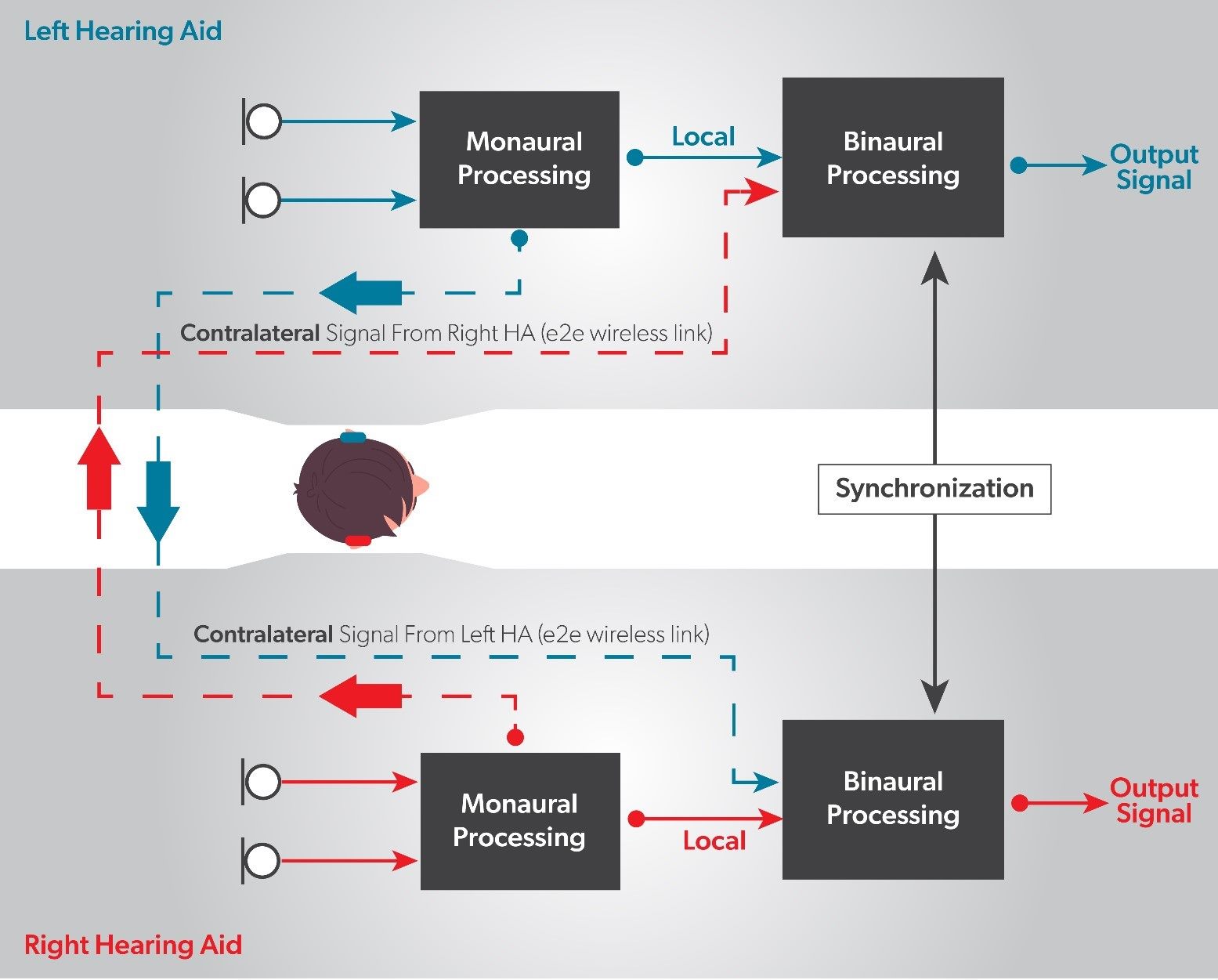
Figure 1. A schematic representation of how NFMI transmission is applied to bilateral beamforming.
Early implementations of NFMI focused on synchronization of settings such as volume control, program selection, and signal classification settings. This ensured, after the hearing aids were programmed, a balance between the right and left ears was maintained during real-world operation. Over the twenty-plus years that NFMI has been used in hearing aids, the amount of data exchanged between devices has increased while transmission time has decreased.
The dependable short-range communication of NFMI has one significant drawback: The transmission distance of the signal is extremely limited. For wireless communication between hearing aids, however, this limitation is actually an advantage, as NFMI transmission maintains communication between bilaterally fitted hearing aids while limiting the risk of interference from external sources. In contrast, the short transmission distance of NFMI makes it a poor choice for audio streaming. In these cases, a different type of wireless transmission, covering a greater distance, is necessary. This other type of wireless transmission is often Bluetooth.
Bluetooth vs. 2.4 GHz
Before reviewing the various types of Bluetooth applications found in today’s prescription hearing aids, let’s address an important detail. One of the most common questions is, what is the difference between Bluetooth and a 2.4 GHz transmission signal? While 2.4GHz and Bluetooth are often used interchangeably, they are not the same thing. Bluetooth is a specific wireless communication protocol that operates within the 2.4 GHz frequency band. Essentially, 2.4 GHz refers to the frequency band, while Bluetooth is a specific technology that uses that band for wireless communication. Think of it like this:
The 2.4 GHz band is the highway, while Bluetooth is a specific type of vehicle (a car, bus, or semi) that travels on that highway.
Bluetooth
Bluetooth (see Bluetooth® Technology Website) is top of mind when it comes to wireless streaming. Developed by Ericsson in the mid-to-late 1990’s, Bluetooth is a popular, short range means of transmitting data in the 2.4 GHz ISM band which ranges from 2.4 GHz to 2.4835 GHz. (ISM stands for Industrial, Scientific, and Medical.) This refers to the specific frequency bands (like the 2.4 GHz band used by Bluetooth) reserved for use by these industries without requiring a license. These bands are commonly used for low-power, short-range communication such as a wireless audio streaming in hearing aids.
By using a technique called frequency hopping in which the transmission signal “hops” between different frequencies, the data can be transmitted with improved security and reduced interference. Typically, the Bluetooth signal is a unicast (one-to-one) transmission, although some recent updates to Bluetooth are introducing a broadcast (one-to-many) capability.
When data is transferred, it must be compressed for transmission and then extracted for use on the receiving side. As part of this process, the signal is encoded and decoded in the transfer by means of a codec. The codec basically determines the quality of the audio transfer. The most widely used, and most practical for hearing aid applications, is the low complexity sub-band codec (SBC). Although this is the most basic standard of codec, it offers better than CD-quality transmission. Other codecs used in Bluetooth offer higher quality, often more appropriate for audiophiles, but also with higher power consumption. However, one codec, the Low Complexity Communication Codec (LC3), is expected to serve as a sequel to the SBC and is included in the newer Bluetooth LE Audio protocol (more on this protocol later).
For the transmission to occur, the wireless devices must be both paired and connected. Pairing indicates that two devices have been introduced to one another and entered into one another’s list-allowed devices. To transmit data, the devices must both be connected indicating that they are both ready to transmit data between one another. Single-point and multi-point connections bring some variation to the connection process. Single-point connection indicates that the Bluetooth device can transmit/receive data with only one other connected device at a time. A single-point device can be paired to multiple devices and the user manually changes the Bluetooth connection to the preferred device. Multi-point connection allows a Bluetooth device to be connected (ready to transmit/receive data) to more than one device at a time. Multi-point connection enables automatic switching of streamed audio between Bluetooth devices but is dependent on device priorities. For hearing aid wearers, the benefit of single-point or multipoint is based on individual preferences. With a multipoint connection, a hearing aid wearer may be watching television and if any type of signal from a phone arrives, it will divert to the phone signal automatically. With single-point connections, in the same scenario, a notification alerts the wearer of a phone call, but the wearer manually switches to the phone. This single-point approach keeps the wearer in more control of what is being streamed.
As previously mentioned, there are different types of Bluetooth protocols used in today’s prescription hearing aids. The next section reviews each type of Bluetooth protocol found in them.
Bluetooth Classic
Bluetooth Classic is arguably the best-known form of Bluetooth transmission; however, it is probably the least integrated into hearing aids. Bluetooth Classic, as the name implies, was the first type of Bluetooth transmission introduced to the market, and there have been several iterations of it since then. Originally intended as a replacement or substitute for wired connections, it is designed to handle data transfer for applications such as printing and gaming. Of course it is also used for audio streaming.
If it is designed for audio transfer, why is Bluetooth Classic not more widely used in hearing aids? Bluetooth Classic, unfortunately, is a power-hungry technology, and traditional methods of powering hearing aids were ill-equipped to support it. Initial applications would use a relay that communicated with the hearing aids via a different wireless protocol such as NFMI, and then the relay device with its larger battery would interface with a phone or other device. More recently, some hearing aid manufacturers using lithium-ion rechargeable batteries have developed hearing aids with integrated Bluetooth Classic technology, negating the need for a relay. This more recent application of Bluetooth Classic also offers wireless connectivity to nearly all consumer devices using Bluetooth. For clinicians, the availability of Bluetooth Classic in hearing aids limits concerns about the type of phone a wearer may have, spending unnecessary time on deciphering connectivity options.
Bluetooth Low Energy, MFi and ASHA
Bluetooth Low Energy (BTLE) is another form of Bluetooth that has grown in use over time. It was initially intended as a means of data transfer with lower power consumption. For hearing aid applications, this initially seems very appealing, until one learns that it was never really intended for audio streaming. The initial use for BTLE with hearing aids was limited as a programming interface and for data sharing to apps with functions such as remote control via a mobile phone.
Despite the intended use of BTLE, developers at Apple did design a way to use BTLE for audio streaming. Many clinicians are familiar with Made for iPhone (MFi) with hearing aids. When used with the Apple ecosystem, this historically has been a popular method of directly streaming audio using iPhones.
Several years later, Google introduced Audio Streaming for Hearing Aids (ASHA) which provided one-way audio streaming via BTLE for Android-based devices. Bluetooth Low Energy using MFi and ASHA are commonly used with hearing aids. However, there are limitations related to phone compatibility with MFI and ASHA which add complexity to the hearing aid fitting process. Pairing hearing aids with either MFi or AHSA to other devices usually is not intuitive for consumers, as the pairing process does not use the traditional Bluetooth pairing method associated with Bluetooth Classic.
Bluetooth Low Energy Audio (LE Audio) and Auracast
Bluetooth Low Energy Audio (LE Audio) is the latest addition to the Bluetooth family. As the name implies, it is designed specifically for audio streaming at a much lower energy cost compared to previous protocols. LE Audio uses the newer LC3 codec, which provides improved sound quality over the other Bluetooth options. The biggest challenge clinically is that LE Audio is a relatively new technology. ince LE Audio only has been commercially available since 2022, not all prescription hearing aids support it. Moreover, it is possible that a hearing aid wearer’s phone may not be compatible with the LE Audio.
Another aspect of LE Audio garnering recent attention is an application known as Auracast. Auracast is designed to provide broadcast capabilities for Bluetooth LE Audio. Airports, movie theatres, playhouses and auditoriums are among the public places where Auracast broadcasting is becoming available. Auracast, eventually, will have a prominent place in the assistive listening systems (ALS) found in these public settings, where t-coils and loop systems remain quite popular. However, technical standards supporting ALS systems, International Electrotechnical Commission (IEC) 60118-17 standards, are not expected to be finalized until 2027, suggesting that Auracast is still in an introductory phase. Given the current lack of technical standards, Auracast broadcasting is not expected to have significant market penetration for a few more years. It should be noted, however, that several marquee venues around the world including the Sydney Opera House have publicized their recent installation of Auracast systems.
Signia’s Implementation of Wireless Technologies
Signia’s latest hearing aid technology, the IX platform, utilizes its 4th generation of NFMI technology, called e2e wireless 4.0, as well as all three Bluetooth applications.
The NFMI used in IX technology provides high speed, reliable binaural synchronization (data/audio sharing) between devices. Many of these applications are outlined in Table 2. Other prescription hearing aids on the market do not use NFMI and instead rely on a 2.4 GHz option for data/audio sharing between devices. Since a 2.4 GHz transmission signal for wireless ear to ear communication is associated with a risk of dropouts, Signia does not compromise sound quality in their wireless ear-to-ear communication strategy, which uses NFMI.
A key feature in IX technology, which relies on NFMI, is Real Time Conversation Enhancement (RTCE) – a feature designed to optimize wearer performance in group conversations. (For a detailed explanation of RTCE see this white paper from Jensen et al., 2025.) Group conversations in noise have typically required a wearer to turn towards each talker to keep that specific talker in a directional beam, thus limiting detecting speech onset from other talkers and missing parts of the conversation or using a more omnidirectional setting which allows more noise to bleed into the conversation. With RTCE, multiple directional beams are engaged to focus on individual talkers in the group to prioritize speech from each talker while reducing competing background noise.
Several other IX features utilize NFMI (Taghvaei & Harris, 2024) including:
- Augmented Focus uses split processing in which front field target signals are processed separately from competing rear field signals.
- Own Voice Processing detects when the wearer is talking to reduce the wearer’s own speech.
- Narrow Directionality provides better than normal speech intelligibility in loud background noise.
- CROS and BiCROS with skewed directionality for those with single-sided deafness focuses on speech from the poorer hearing side in background noise.
With the update to the IX platform in 2024, Signia has added LE Audio compatibility to its existing portfolio that are already MFi and ASHA compatible. With the recent addition of the Signia BCT IX, there is a new option with Bluetooth Classic. This provides additional connectivity options with the IX platform for phones and other devices that did not support the MFi, ASHA, and LE Audio protocols.
Bluetooth audio streaming is not confined to smartphone-integrated hearing aids. Most manufacturers offer a Bluetooth-enabled wireless streamer for televisions (e.g., Signia TV Sound). Like smartphones, audio streaming to the television requires pairing to the hearing aids, and offers the wearer considerable potential benefit for television viewing at home.
Bluetooth Classic is a universal streaming protocol found in a wide range of consumer audio devices. With the wireless features provided by Signia IX, there is no compromise in wireless communication between devices or with optimizing connectivity with other devices. In addition, the HCP can focus on the hearing aid fitting rather than on the type of phone the patient uses.
Wireless Solutions - Part 2, Wireless Audio Streaming Candidacy & Goal Setting Process
As described in Part 1, there are myriad wireless technologies on-board all of today’s prescription hearing aid brands, including several different audio streaming protocols. Depending on the hearing aid’s specific wireless protocol, the wearer can connect to one or more consumer electronic devices. Because of the number of wireless audio streaming options available across brands, clinicians must give more thought and attention to wireless streaming candidacy issues. Some individuals may value wireless audio streaming and benefit from it on Day 1 of hearing aid use. Others may choose to ignore the wireless audio streaming features and never use them; while a few might be wireless audio streaming-curious, needing coaxing and coaching from others to begin using their smartphone-integrated hearing aids – sometimes a year or more after acquiring it. The challenge for clinicians, then, is the difficulty in determining exactly who will benefit from wireless audio streaming, how much instruction is needed or when audio streaming should be activated. Clinicians are limited by time, and the attention of the individual during appointments, so it can be challenging to thoroughly address the critical details of wireless audio streaming candidacy and use.
The purpose of Part 2 is to outline a practical strategy for determining how Bluetooth wireless audio streaming features can be prioritized for new hearing aid wearers. Further, this tutorial provides common-sense insights on when and how to introduce Bluetooth audio streaming into the individual’s communication goals as targeted on the Client-oriented Scale of Improvement (COSI).
Smartphone-integrated Hearing Aids Are Needed
To fully adopt and use smartphone-integrated hearing aids, obviously, wearers must first possess a smartphone. A substantial number of first-time hearing aid wearers have yet to adopt full-time use of a smartphone, however, recent data indicates this trend is shifting. According to the most current Pew Research survey, the percentage of older adults owning smartphones has risen substantially in recent years, with a 2021 survey showing that 61% of those 65 years and older own a smartphone. This is up from 53% in 2019 (Pendlebury, 2021) and reflects a trend which is likely to continue: increased smartphone-enabled technology adoption by older adults. Several factors may contribute to the growing adoption of smartphone-based technology among older adults. These include the need to stay connected with family and friends, the desire to access information and entertainment, and the increasing availability of user-friendly smartphone-based technology. Use of a smartphone for social connectedness goes beyond family and close friends. One study found that as older adults’ ties to their families weaken, they strengthen their relationships with others in order to stay socially connected. Smartphones are often used to strengthen these connections with other non-family members (Xu et al., 2023). Together, survey data shows a trend toward greater smartphone use by older adults.
The popularity of wireless audio streaming, a feature requiring smartphone-integrated hearing aids, also appears to be rising. A recent analysis of more than 891,000 adult hearing aid wearers from around the world indicated that just over 50% of wearers of a recently launched premium hearing aid used their hearing aids to stream music, podcasts or phone calls at least once a day (Pruess & Bulut, 2025). The researchers also reported that respondents’ current streaming time with the newest model represented a 5 to 8% increase in streaming time compared to those wearing hearing aids from previous platforms of the same brand. Finally, the researchers reported the average amount of time per day streaming was 36.5 minutes, a three-to-four-minute increase over earlier platforms. These data suggest that a growing number of hearing aid wearers, albeit slowly, are spending more time streaming directly to their hearing aids to do three things in roughly equal numbers: listening to music, listening to podcasts or conversing on the phone.
Overcoming the Digital Divide: Triaging Wireless Audio Streaming Candidates
According to the Audiology Practice Standards Association (APSO) guideline S2.1 Hearing Aid Fitting for Adult & Geriatric Patients (2021), “assistive technology and accessories are considered to facilitate accessibility to other devices and to satisfy the wearer’s listening and communication needs.” Given these best-practice guidelines, a key part of hearing aid fitting procedures should include a careful assessment of wireless audio streaming candidacy. Clinicians should also note that hearing aids with Bluetooth streaming capability yield higher self-reported satisfaction ratings compared to hearing aids without streaming (Picou et al., 2022).
If the availability of Bluetooth wireless audio streaming in hearing aids leads to better outcomes and APSO guidelines call for recommending it, then clinicians should considered triaging hearing aid wearers into the following three categories during the hearing aid evaluation appointment:
- Competent and Confident Streamers: Wearers likely to benefit from wireless audio streaming immediately and need little to no additional instruction and guidance on how to integrate their smartphone into the wireless streaming process.
- Coachable Streamers: Wearers likely to benefit from wireless audio streaming but require additional instruction and guidance on how to successfully integrate their smartphone into the wireless streaming process.
- Non-streamers: Wearers unlikely to want or need wireless audio streaming. However, their desire or need to use wireless streaming may change in the future. Hence, wireless streaming abilities should be re-assessed at periodic follow-up visits.
Wireless Audio Streaming Candidacy Considerations: Three Categories, Five Questions
Self-assessment inventories have been a valuable part of the hearing aid selection and fitting process for many years. As detailed by Taylor & Mueller (2025), self-assessment inventories can be used to a.) determine if there is impairment or disability, b.) as a needs assessment for treatment planning, and c.) as a validation measure of benefit, satisfaction and quality of life improvements. During an initial consultation, self-assessment inventories can be a particularly useful way to quickly identify listening situations where the individual is experiencing communication difficulties and to prioritize hearing aid features important to the individual.
Some self-assessment inventories help clinicians select the most suitable hearing aid features based on the individual's priorities and needs. The Hearing Aid Selection Profile (HASP), developed by Jacobson et al (2001), and its cousin, the 9-question Characteristics of Amplification Tool (COAT), developed by Sandridge and Newman (2006) are two such self-assessments that have been used to prioritize hearing aid features for the individual. The COAT, developed 20 years ago, does not have any questions that rate the importance of wireless audio streaming. Consequently, its practicality in a world awash in smartphone-integrated hearing aids is limited.
Recently, researchers at Western University developed the Hearing Aid Attribute Feature and Importance Evaluation (HAFIE) questionnaire (Saleh, et al 2023). The HAFIE is divided into nine sections: Smartphone-based Technology, Multi-environment Functionality, Comfort and Appearance, Convenience and Connectivity, Ease of Use, Audibility and Speech Intelligibility, Streaming, Batteries & Charging, and Hearing Aid Styles. The creators of the HAFIE have also developed a 14-item shortened version. Although 14 items is still too long for clinical use, there are three HAFIE questions, when modified, that can be used in the wireless audio streaming candidacy triaging process.
The first step in the wireless audio streaming triaging process is determining the importance of using wireless features for the individual. This step is completed by administering the three streaming questions, adapted from the HAFIE. Figure 2 illustrates the three streaming questions that are asked during the hearing aid evaluation appointment to judge the priorities and needs of the prospective wearer. If the individual ranks any of the three questions as “very important” or “important,” this would be an indication the individual falls into either Category 1 (Competent and Confident Streamer) or Category 2 (Coachable Streamer), and communication goals involving wireless streaming can be immediately targeted and recorded on the COSI.
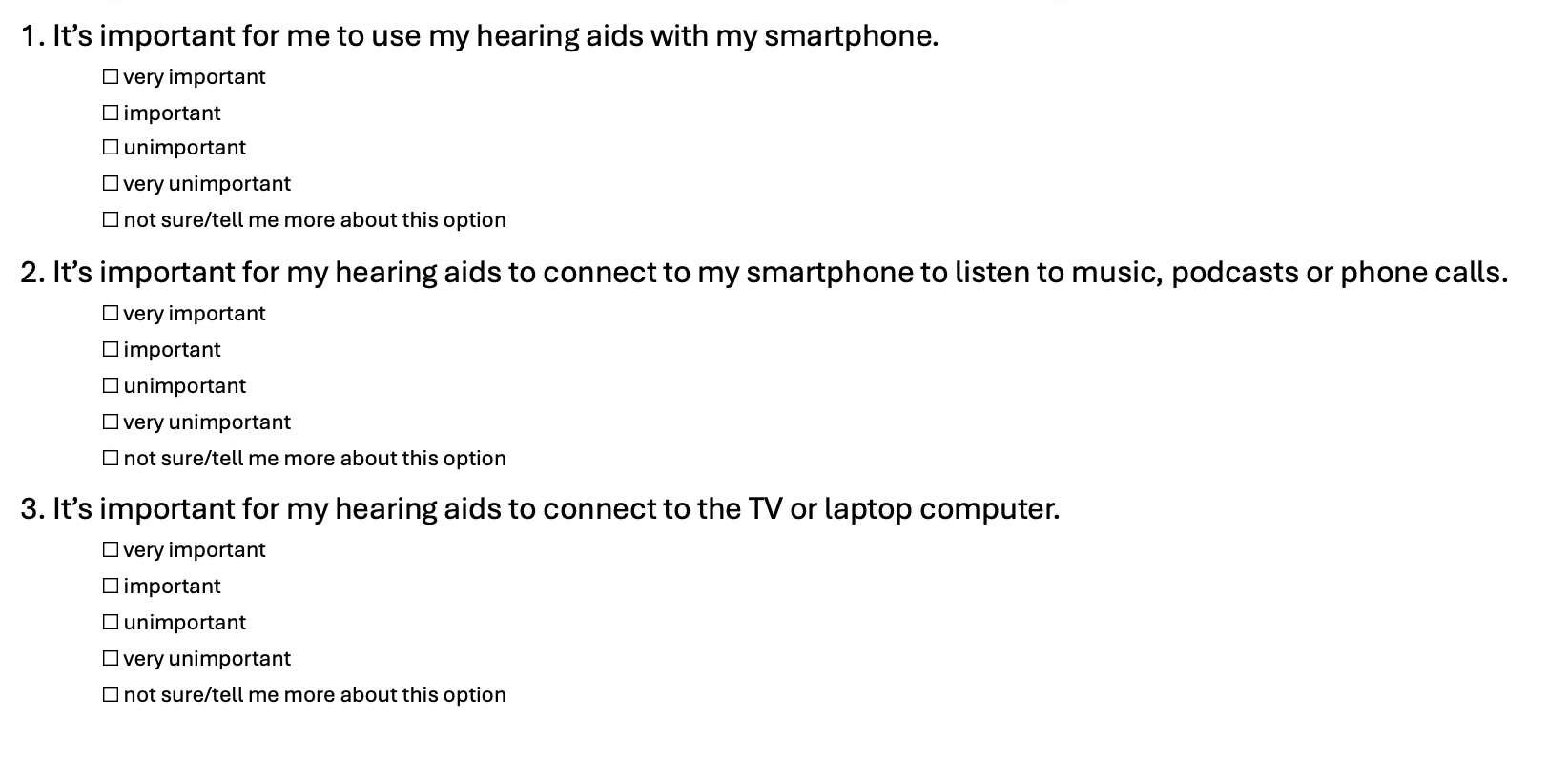
Figure 2. Three wireless streaming questions, modified from the HAFIE (Saleh et al., 2024).
The second step in the wireless streaming triaging process is assessing the digital literacy of the individual. After all, if an individual lacks the skills and self-confidence to navigate smartphone-integrated features, even when the ability to stream is deemed important, that person is unlikely to receive benefit from wireless audio streaming. Digital literacy refers to the ability to effectively and responsibly use a smartphone, computer and other forms of modern electronic communication in everyday life. Included in this definition is the ability to navigate the basic interface of a smartphone, use the smartphone or computer to communicate with others via texting, talking, e-mailing, and the ability to search for, assess, and verify the credibility of online information accessed through a smartphone or computer (Roque & Boot, 2018). In short, to effectively use smartphone-integrated wireless audio streaming in hearing aids, individuals must be digitally literate.
Considering the prevalence of smartphone-integrated hearing aids and their potential benefits, assessing digital literacy of all prospective wearers is essential. Ferguson et al. (2024) developed the two-question Digital Literacy (DL-2Q) questionnaire to better understand the tech savviness of hearing aid candidates. The DL-2Q, illustrated in Figure 3, is comprised of two questions, one that evaluates smartphone skills (competency) and the other that evaluates self-belief (confidence) in using smartphones. Note that in the original version of the DL-2Q, the term, mobile phone is used. The version shown here substitutes the term, smartphone, because it is more commonly used in the U.S.
Ferguson et al. (2024) validated the DL-2Q by comparing results of 110 adults ranging in age from 52 to 96 years to the 16-question Mobile Device Proficiency Questionnaire (MDPQ-16) (Roque & Boot, 2018). They showed a positive association between the MDPQ-16 and DL-2Q, indicating the DL-2Q is a valid measure of smartphone digital literacy.
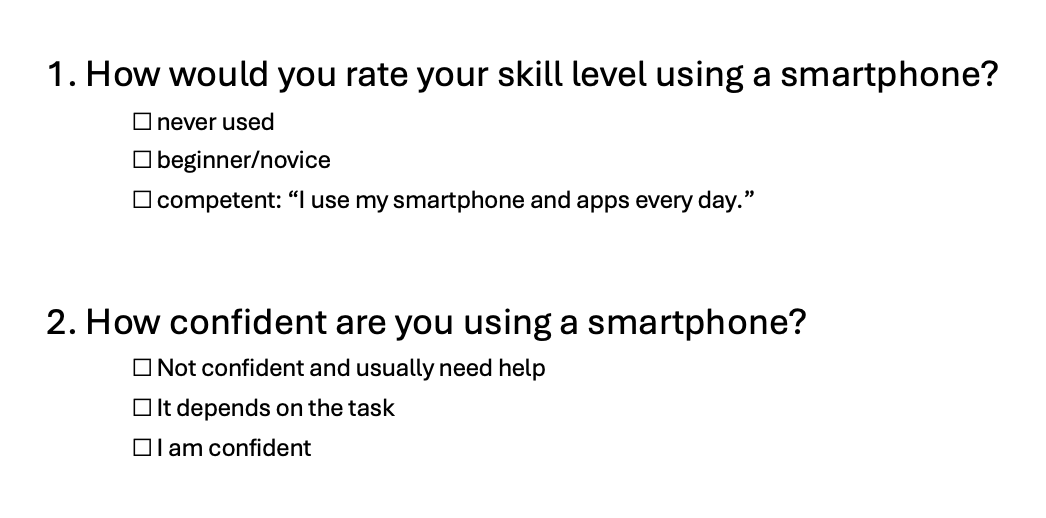
Figure 3. The DL-2Q developed and validated by Ferguson et al. (2024).
In their validation of the DL-2Q, which compared participant scores on it to the MDPQ-16, Ferguson et al. (2024) uncovered two clinically useful findings, depicted in Figure 4. First, it shows that younger adults (52 to 64 years old) and older adults (86 to 92 years old) are aligned with how we might expect age to influence digital literacy: The oldest adults have poor digital literacy relative to the youngest adults who participated in the study. Second, as designated with the red box in Figure 4, 76% of the adults aged 65 to 85 years old had digital proficiency scores better than the average MDPQ-16 score, indicating that 24% of adults in this age range score below average on digital literacy competence (represented by the blue box in Figure 4).
Ferguson et al. (2024) also found there was a mismatch between competence and confidence for the group aged 65 to 85 years old. They reported that 44% of individuals in this age group were digitally competent but lacked confidence when completing smartphone-related tasks. Since most first-time hearing aid wearers are in the 65- to 85-year-old age range, these findings are clinically meaningful and suggest there are ample opportunities for clinicians to improve smartphone literacy skills through education, training and other tactics that empower the individual.
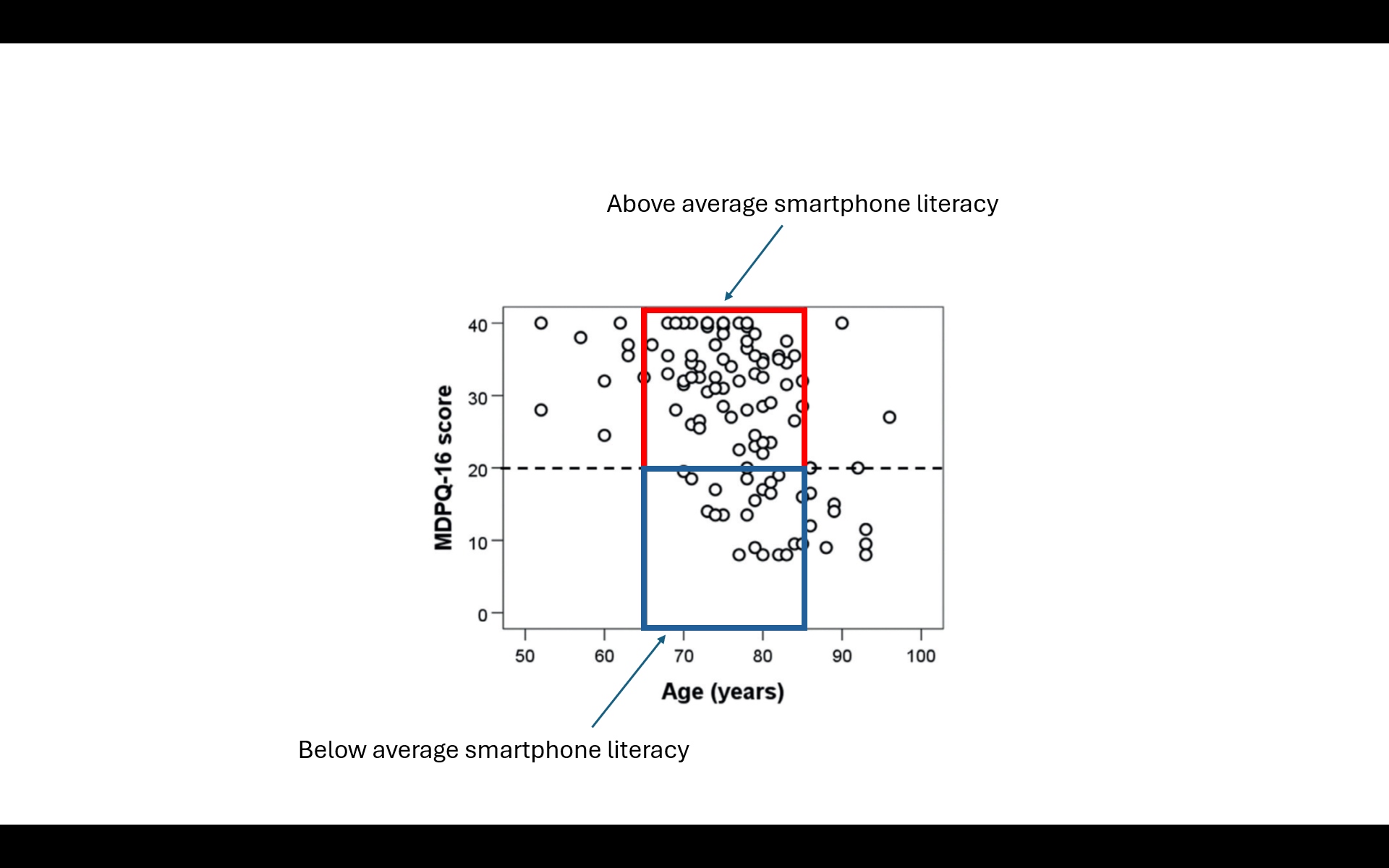
Figure 4. Each circle represents a participant’s score on the MDPQ-16 as a function of age. The dotted line is the midpoint for the MDPQ-16. The vertical lines show the midpoint scores for the 65- to 85-year-olds. Modified from Ferguson et al. (2024).
Applying the Answers to the 5-Questions During Goal Setting
The three streaming questions from the modified HAFIE, combined with the DL-2Q, could be a useful approach to triaging wearers into three categories a.) Competent and Confident Wireless Streamers b.) Coachable Streamers, or c.) Non-Streamers. Table 3 illustrates the results for the 3-questions HAFIE and DL-2Q along with how to apply those findings in the goal setting and treatment planning process.
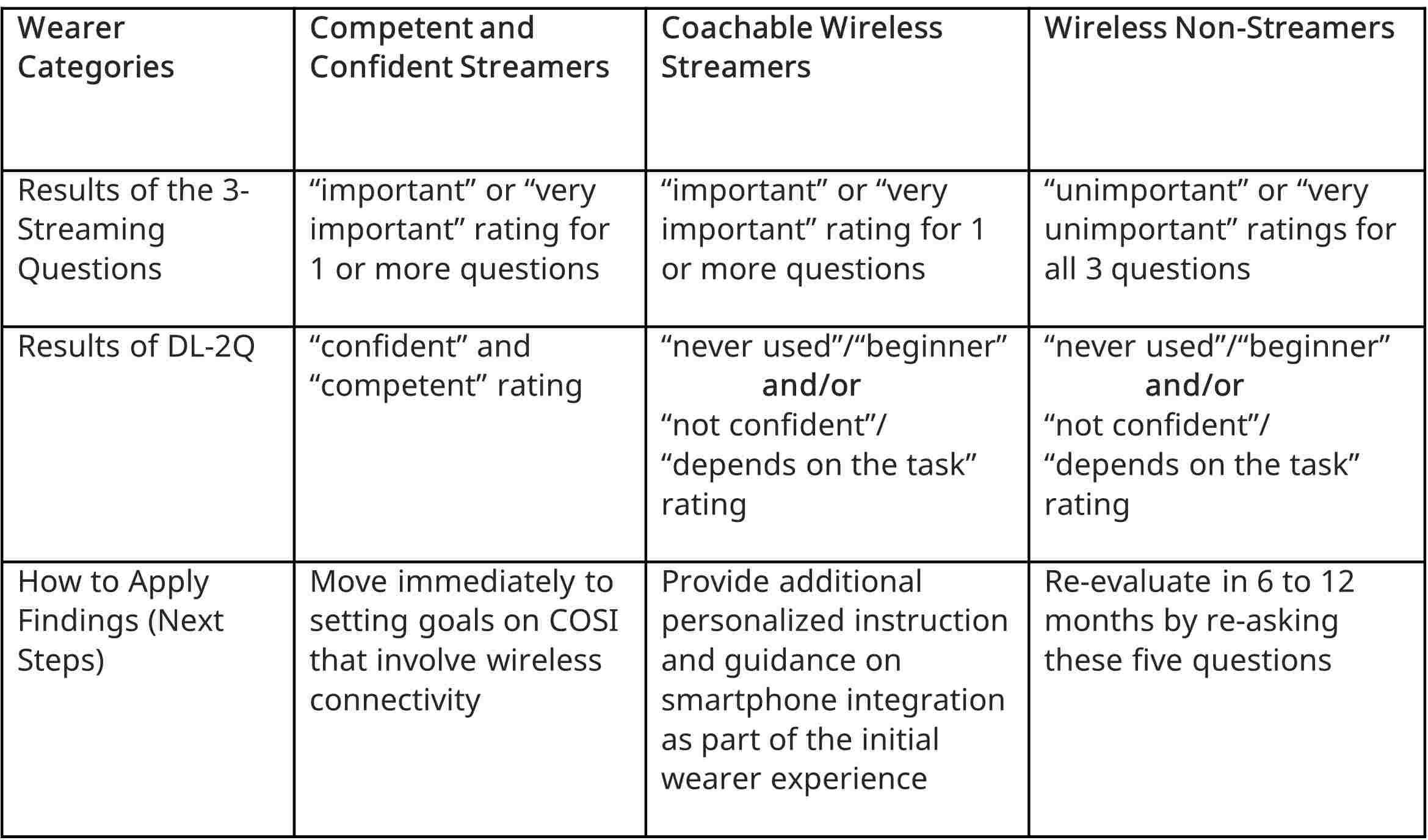
Table 3. Three categories of smartphone-integrated hearing aid wearers, results from 3-streaming questions + the DL-2Q and a summary of how to apply those findings in the goal-setting process.
Smartphone-Competency vs. Smartphone-Confidence: What Needs to be Coached?
The DL-2Q assesses digital literacy along two fronts: competency and confidence. Competence refers to an individual’s skills, knowledge, and abilities an individual possesses to perform a specific task effectively. Confidence, on the other hand, is the belief in one's ability to succeed and take action, even if that individual is competent in the specific skill or expertise.There are many ways to describe the difference between competence and confidence. One example is an athlete competing in the Olympics. Obviously, the athlete who has qualified for the Olympics is highly competent, but if he is so nervous before this epic occasion that his performance suffers, it is possible his low self-confidence might be a contributing factor. In contrast, the sprinter who dominates in the 100-meter dash at his local high school might be abundantly confident he can compete with Division I sprinters. But when the opportunity to compete with them arises, he falls woefully short of his expectations and embarrasses himself. The latter is an example of overconfidence.
You don’t need to be an athlete to appreciate that the same basic principle holds true with smartphone-integrated hearing aids. A wearer might display a high level of smartphone competence but when faced with a new task, like integrating it with hearing aids to stream a favorite podcast, low self-confidence associated with the task of combining the smartphone with hearing aids inhibits successful use. Conversely, a wearer might be so overconfident in using the streaming capabilities of his new smartphone-integrated hearing aids that he is embarrassed by his own ineptness, gives up too soon and never attempts streaming with his hearing aids again. The challenge for clinicians is recognizing when the wearer needs a boost in self-belief in ability (confidence) or improved skills (competence) to successfully integrate hearing aids with a smartphone and then providing the appropriate assistance.
Table 4 outlines intervention strategies, employed by the clinician that can be used to boost the confidence or competence of wearers who wish to integrate the audio streaming capability of their smartphone with hearing aids. Column 1 outlines three “empowerment tactics,” designed to boost the confidence of wearers in their adoption of smartphone-integrated hearing aids for audio streaming. Column 2 outlines three skills that can be improved with intervention from the clinician, designed to boost wearer competence.
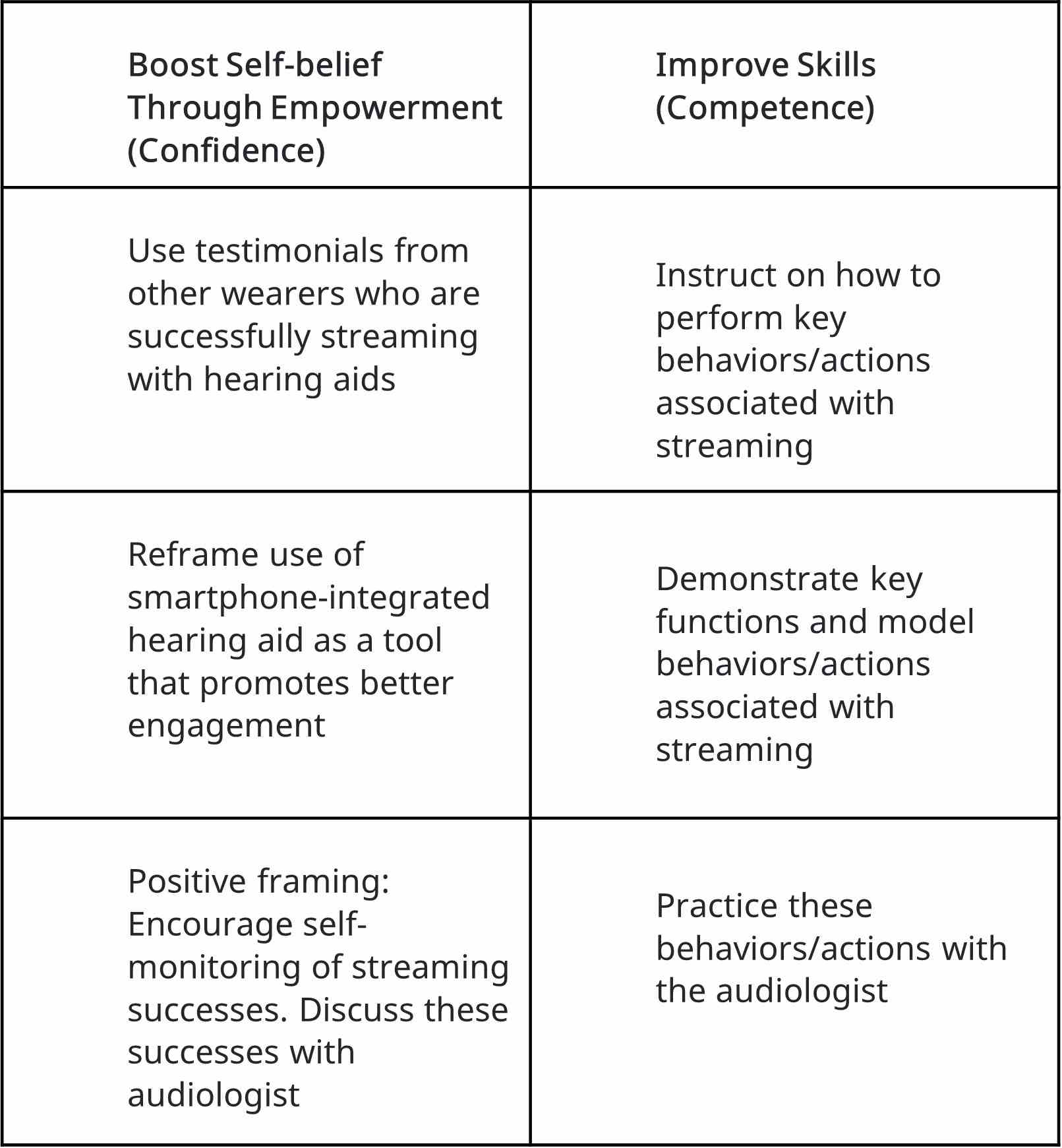
Table 4. A summary of tactics that can be used in the clinic to promote improved digital literacy and empowerment with smartphone-integrated hearing aids and streaming.
Empowered wearers, when equipped with the beliefs and skills to independently navigate smartphone-integrated hearing aids, are likely to be more successful adopters of audio streaming technology (Gomez et al. 2021). Nevertheless, clinicians must recognize who might need additional coaching and to determine when streaming technology should be introduced into the treatment plan.
For individuals considered to be confident and competent streamers, clinicians are encouraged to move directly into the goal setting process. Using the Client-Oriented Scale of Improvement (COSI), goals that involve the use of wireless audio streaming can be individualized and recorded, as shown in Figure 5.
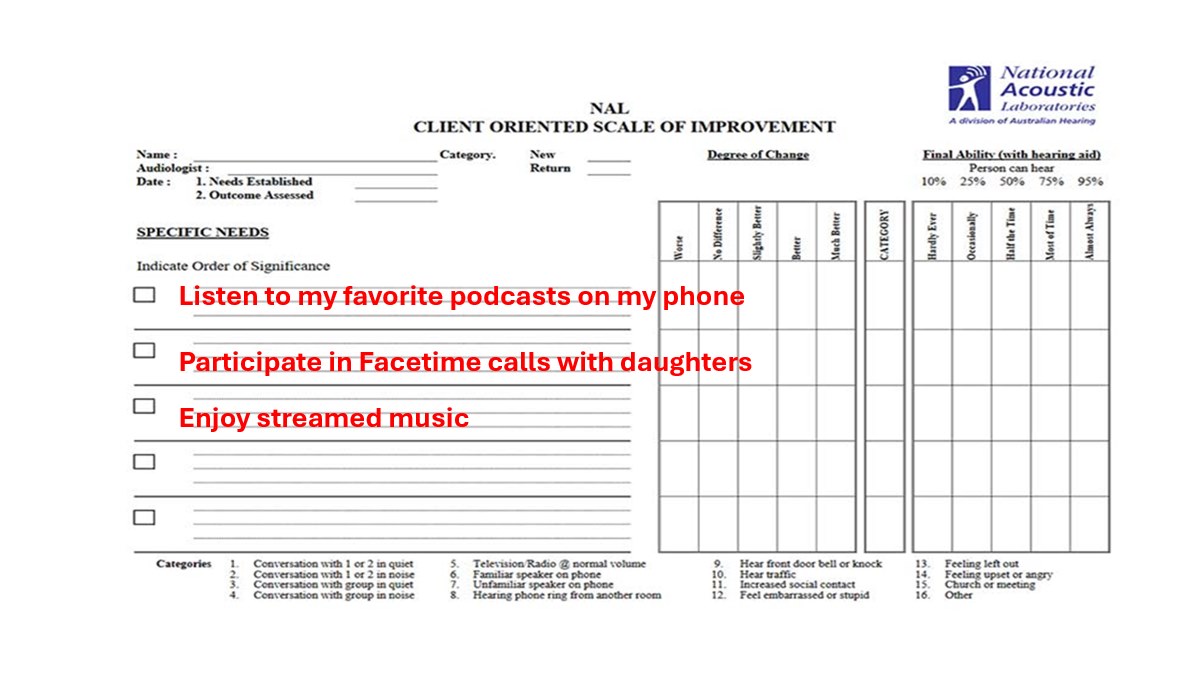
Figure 5. An example of the COSI with goals for an individual deemed to be confident and competent streamers. Note these “streaming” goals are created after the clinician determines the individual to be a competent and confident streamer.
For individuals who express that wireless audio streaming is important, but lack competence or confidence (Coachable Streamers), clinicians are encouraged to provide more detailed instruction on smartphone-integrated hearing aids. This instruction should be geared toward skill development and empowerment that enable the wearer to become a self-confident and independent wireless streamer. Intervention strategies, summarized in Table 4, could take the form of an unbundled, fee-for-service arrangement for Coachable Streamers.
Finally, for individuals who are determined to be non-streamers at their initial evaluation, their status should be re-assessed using the same five questions at scheduled, periodic follow-up appointments. Skills training and confidence building can be introduced several months, even years, after their initial hearing aid acquisition. Given the substantially higher satisfaction ratings of individuals with wireless audio streaming on their hearing aids, as illustrated in Figure 6, all wearers, regardless of age or digital literacy, should be given the opportunity to take advantage of smartphone-integrated hearing aids and wireless audio streaming - now or in a few years.
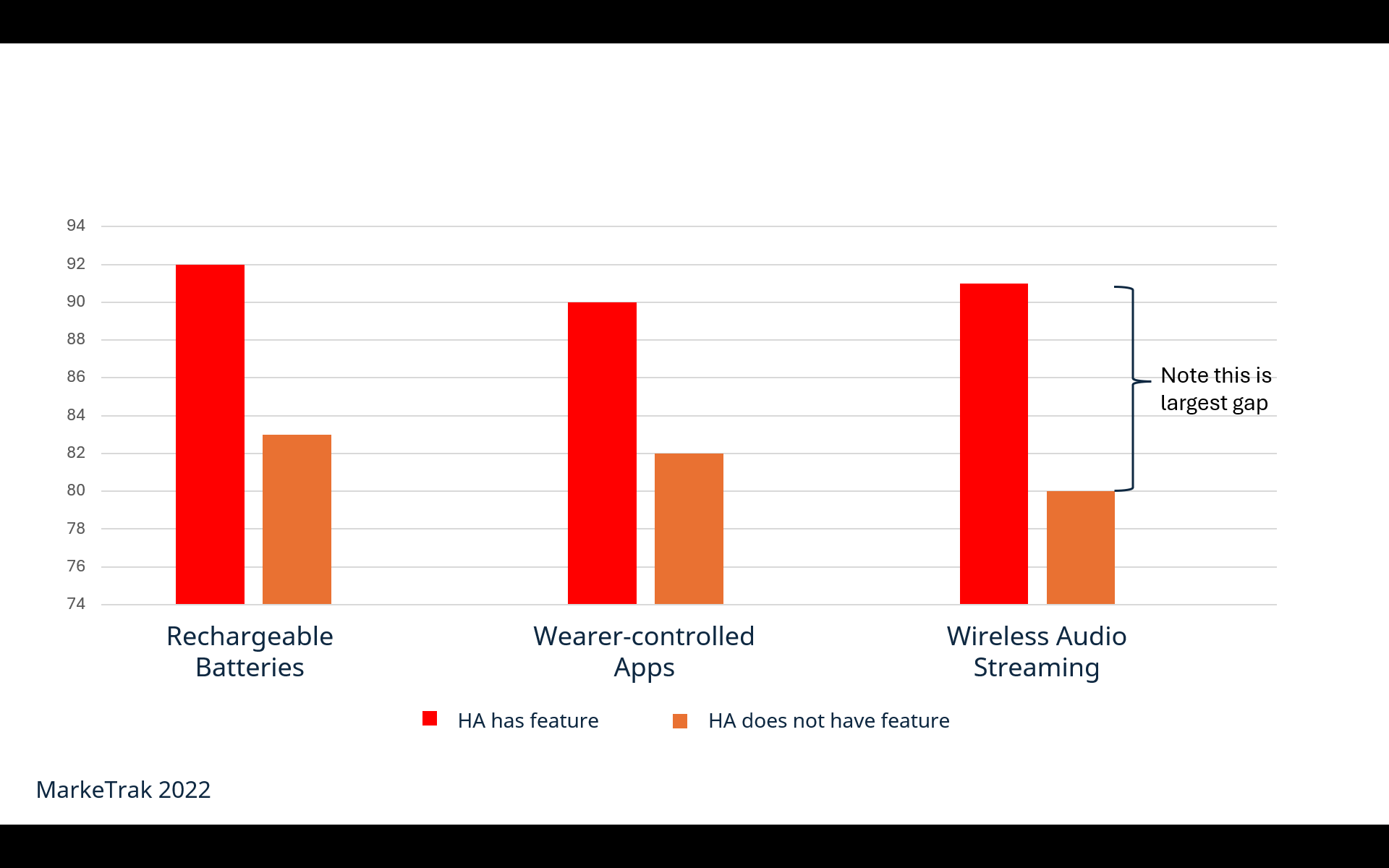
Figure 6. Overall satisfaction scores for two groups of wearers for three new generation hearing aid features. Adapted from Picou (2022).
In Closing
As wireless technologies in hearing aids continue to evolve, we are likely to see further enhancements in wearer performance, devices that are easier to use, and as a consequence, additional wearer benefits. In the end, this is the incremental nature of technology – a feature of modern life that everyone takes for granted in 2025, some 30 years after the dawn on the internet and cellphones. At the same time, we cannot assume individuals with hearing loss, even those who have used smartphones for decades, will intuitively know how to unlock these smartphone-integrated features. Other human beings, namely audiologists and other hearing professionals, will be called upon to assess, guide, and empower persons with hearing loss as they navigate the details of wireless audio streaming and other features, some of which don’t yet exist, associated with smartphone-integrated hearing aids. This tutorial hopes to stir thoughts in the minds of clinicians, and how they help individuals with hearing loss make the most seamless connections from these wireless technologies.
References
Audiology Practice Standards Organization. (n.d.). S2.1 – Hearing aid fitting standard for adult and geriatric patient. https://www.audiologystandards.org/standards/display.php?id=102
Ferguson, M., Sahota, T., & Sucher, C. (2024, July 4). Why and how to assess digital literacy of older adults with hearing loss. ENT & Audiology News. https://www.entandaudiologynews.com/features/audiology-features/post/why-and-how-to-assess-digital-literacy-of-older-adults-with-hearing-loss
Jacobson, G. P., Newman, C. W., Fabry, D. A., & Sandridge, S. A. (2001). Development of the Three-Clinic Hearing Aid Selection Profile (HASP). Journal of the American Academy of Audiology, 12, 128–141. https://doi.org/10.1055/s-0040-1715960
Jensen, N.S., Samra, B., Parsi, H.K., & Taylor, B. (2025, February). Beyond the lab: Signia IX with RealTime Conversation Enhancement significantly improves real-world busy group conversation [Signia white paper].
Palmer, C., & Zitelli, L. (2024). Chapter 3: Setting the hearing aid response and verifying signal processing and features in the test box. Seminars in Hearing, 45(2), 172–204.
Pendlebury, T. (2021). Older people are using more smartphones, Pew finds. CNET News. https://www.cnet.com/tech/mobile/older-people-are-using-more-smartphones-pew-finds/
Picou, E. M. (2022). Hearing aid benefit and satisfaction results from the MarkeTrak 2022 survey: Importance of features and hearing care professionals. Seminars in Hearing, 43, 301–316.
Preuss, M., & Bulut, K. (2025). Clinical trends for mild to moderate hearing losses. Phonak Field Study News. https://www.phonak.com/evidence
Roque, N., & Boot, W. (2018). A new tool for assessing mobile device proficiency in older adults: The Mobile Device Proficiency Questionnaire. Journal of Applied Gerontology, 37(2), 131–156.
Saleh, H. K., Folkeard, P., Liao, S., & Scollie, S. (2024). Development and initial evaluation of the Hearing Aid Attribute and Feature Importance Evaluation (HAFIE) questionnaire. International Journal of Audiology, 63(9), 712–721. https://doi.org/10.1080/14992027.2024.2312229
Sandridge, S., & Newman, C. (2006). Improving the efficiency and accountability of the hearing aid selection process: Use of the COAT. AudiologyOnline. https://www.audiologyonline.com
Taghvaei, N., & Harris, S. (2024). Evolution of wireless communication technology in hearing aids. Audiology Practices, 15(4), 18–28.
Taylor, B. (2024). Beyond good, better, best: How “new generation” features and algorithms are changing the hearing aid selection process. AudiologyOnline, Interview 28875. www.audiologyonline.com
Taylor, B., & Mueller, H. G. (2025). Research QuickTakes Volume 9: Clinical implementation of self-assessment inventories. AudiologyOnline. https://www.audiologyonline.com
Xu, Y., Zeng, K., Dong, L., Zheng, X., & Si, Y. (2023). Understanding older adults’ smartphone addiction in the digital age: Empirical evidence from China. Frontiers in Public Health, 11, 1136494. https://doi.org/10.3389/fpubh.2023.113649
Appendix A
What are New Generation Hearing Aids?
Until recently, hearing aids and consumer electronic devices existed as completely separate product categories. This began to change, however, with the introduction of wireless Bluetooth streaming, a long-time staple of consumer audio, into hearing aids more than a decade ago. As illustrated in Figure 7, a broad range of technology, once limited to consumer audio devices, has incrementally found its way into prescription hearing aids. This convergence of product categories unlocks potential added benefits wearers can experience from prescription hearing aids.
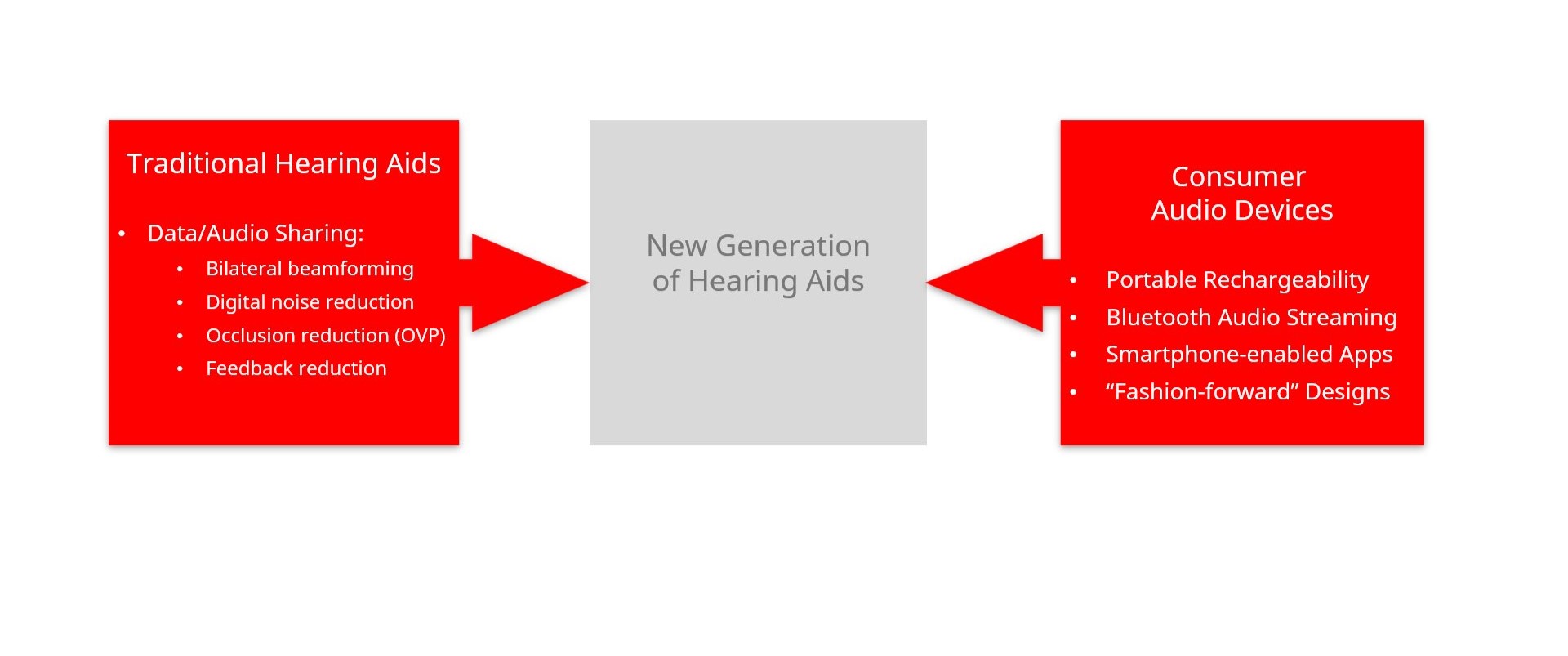
Figure 7. The features in consumer audio devices with the standard wireless features found in prescription hearing aids converge to create new generation hearing aids.
New generation hearing aid features describe technologies traditionally found in consumer audio devices, now commonly available in prescription hearing aids. Features, like rechargeable batteries, Bluetooth audio streaming and smartphone-enabled apps, provide wearers with a more personalized and connected experience -- one more akin to using a smartphone paired to earbuds than traditional hearing aids.
Better Outcomes & Increased Use
Evidence gathered from existing hearing aid wearers reveals another useful finding: Hearing aids with Bluetooth connectivity yield higher levels of satisfaction. Specifically, Picou (2022) using MarkeTrak 2022 survey data indicated wireless audio streaming is one of three new generation hearing aid features that produce higher satisfaction scores for individuals who have those features on their existing hearing aids. This finding is illustrated in Figure 6 of the tutorial.
Additional evidence suggests new generation features, including wireless audio streaming, also contribute to increased self-reported quality of life. Perhaps one of the most remarkable findings in MT 2022 is just how often hearing aids are reported to regularly improve the quality-of-life of their wearers. As summarized in Figure 8, these quality-of-life improvements have steadily risen over the past three MarkeTrak reports. In 2015, for example, 48% of respondents stated that hearing aids regularly improved their quality of life, and in 2022 this number increased to 64%. Given that many new generation hearing aid features were not commercially available before 2019, it is reasonable to assume from MT 2022 data these quality-of-life improvements are associated with a rising number of hearing aids on the market with rechargeable batteries, wearer-controlled apps and wireless audio streaming capabilities.
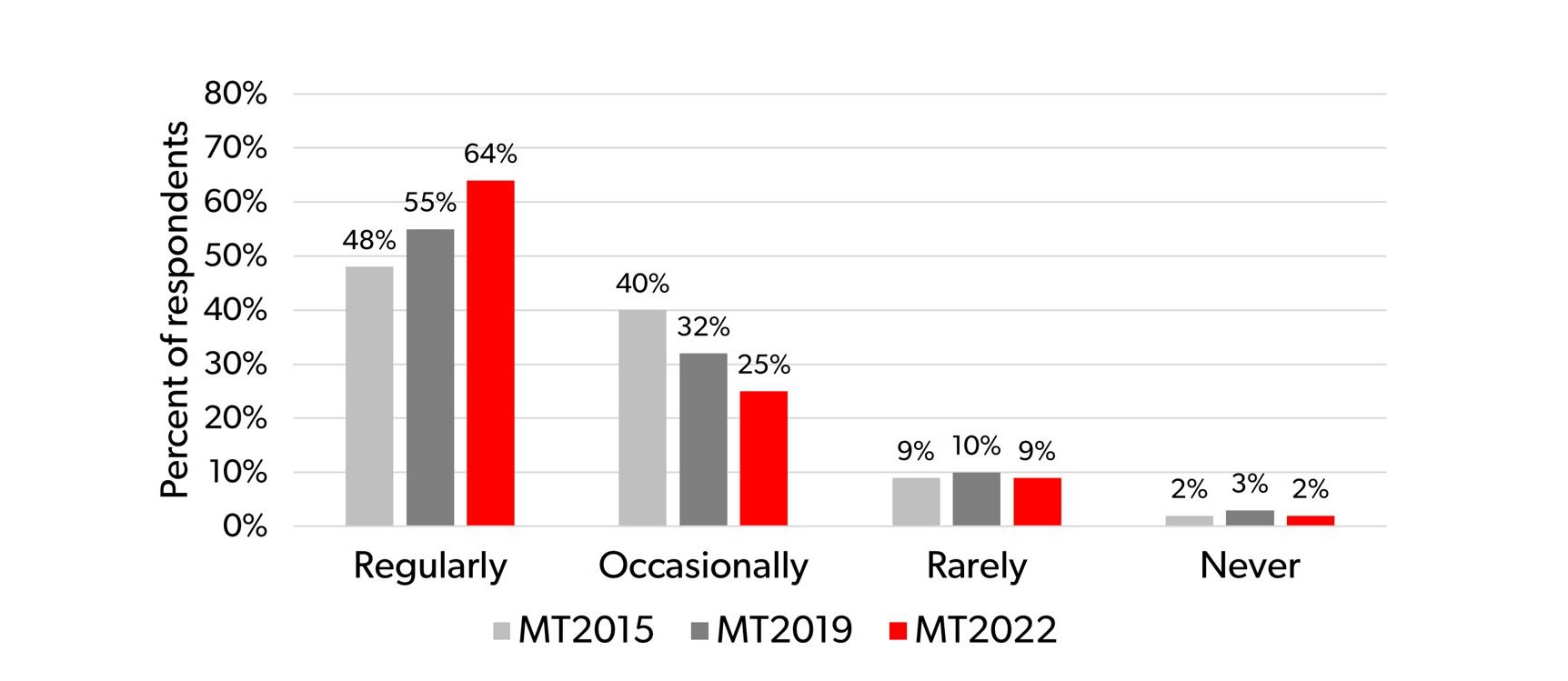
Figure 8. The bars illustrate how often hearing aids are reported to regularly improve quality of life. Percent of hearing aid wearers who report hearing aids regularly, occasionally, rarely, or never improve their quality of life. The plot shows results from three most recently published MarkeTrak survey cycles. Figure adapted from Picou (2022).
For more details on new generation hearing aid features and how they could drive higher levels of patient outcomes, see this 2024 AO article from Taylor (2024).
Appendix B
Terms of Endearment: A Brief History of Wireless Streaming
Although the term wireless streaming is relatively new, the ability to transmit sound to hearing aids without wires has been used for decades. Going back to the 1950s, there have been efforts to promote wireless technology in order to improve wearer benefit in challenging listening situations. There is a good reason that wireless streaming has been a highly sought feature: Whenever the voice of the talker of interest is placed closer to the wearer’s hearing aid microphone, sound quality and intelligibility markedly improve. With wireless streaming, you don’t have to be inches away from the listener; you can be several feet away and still experience the soothing whispers of sweet nothings – or any other timeless message of importance.
Wireless streaming in hearing aids has evolved significantly over the decades, driven by advancements in consumer electronic technology. To appreciate the benefits of wireless streaming features in today’s hearing aids, let’s briefly review the evolution of wireless transmission in hearing aids and many of the terms associated with its use in hearing aids.
Telecoils (1930s-Present)
No, we didn’t forget this essential wireless feature; one still widely used today. And yes, we believe it will remain an indispensable wireless feature for several more years. Now that we have that out of the way, it might be of interest to know the inventor and hearing aid pioneer, Sam Lyberger, was the first to place a telecoil into a hearing aid back in the 1930s. While we’re handing out “thank yous,” a shout-out to the tireless support of telecoil advocate and audiologist, Juliette Sterkens is warranted. She has kept loop systems alive as an essential wireless technology for nearly twenty years.
The first to make our list, the telecoil has been around for about 100 years and remains an important part of any clinician’s toolbox. The underappreciated telecoil remains a standard feature in modern hearing aids. Like a thread woven through the history of wireless streaming, the telecoil and its cousin, the loop system, uses electromagnetic induction to transmit sound directly into hearing aids. Many public listening areas, including auditoriums, theatres and airports continue to operate with induction loop systems that necessitate the need for the wearer to have an operational telecoil. Although telecoils and loop systems are certainly wireless technologies, selection and fitting guidance is well-established (e.g., Palmer & Zitelli, 2024), and it will not be discussed further in this article.
FM Systems (1970s-2000s)
Frequency Modulation (FM) systems were developed to improve hearing in high noise, reverberant environments, especially in educational and public settings. FM transmitters send audio signals wirelessly to hearing aids equipped with FM receivers, significantly improving speech clarity. Although they remain common in classrooms, FM systems require accessories, making them challenging to use for some individuals.
Infrared and Radio Frequency (1980s-2010s)
Infrared and radio frequency (RF) systems were used to connect hearing aids to external devices like TVs and public address systems. Similar to telecoils, infrared and RF are both forms of electromagnetic radiation, but they differ in their wavelengths. Infrared uses invisible light to transmit signals, often in short ranges, while RF uses radio waves for longer-distance communication. Like FM systems, infrared and RF systems tended to be complicated to use, expensive and lacked the flexibility of Bluetooth-enabled protocols.
Early Bluetooth Wireless Protocols (2013-2020s)
The 2010’s saw the introduction of Bluetooth technology in hearing aids, enabling direct streaming of audio from phones, TVs, and other devices. These early Bluetooth-enabled hearing aids relied on an intermediary or relay device, often worn around the neck. for wireless transmission between the hearing aids and electronic device (e.g., phone). Additionally, manufacturers developed proprietary low-energy wireless protocols optimized for hearing aids, as traditional Bluetooth consumed too much power. The introduction of Made-for-iPhone (MFi) hearing aids in 2013 and later Android-compatible hearing aids allowed seamless connectivity (no intermediary device!) with smartphones and other devices. Due in part to high battery consumption and issues related to sound quality, as any clinician from those days keenly remembers, early implementations of Bluetooth wireless protocols were plagued with challenges.
Back to top.
Citation
Taylor, B., & Branda, E. (2025). Seamless connections: A busy clinician’s guide to wireless technology in new generation hearing aids. AudiologyOnline, Article 29339. www.audiologyonline.com



